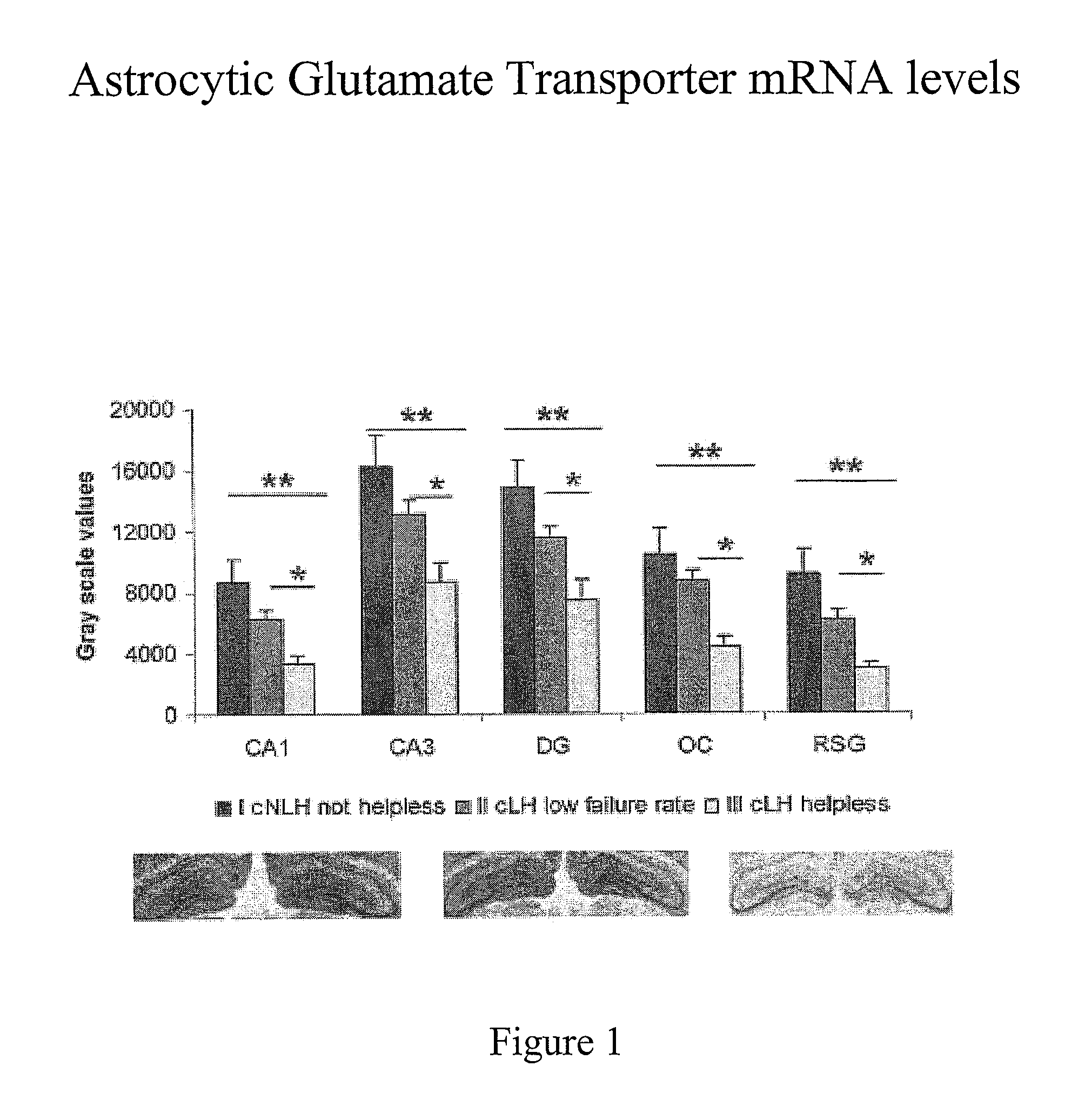Method of treating depression
a depression and disorder technology, applied in the field of treating depression or depressionrelated disorders, can solve the problems of depression, routine never returning, inability to perform daily tasks with the usual vigor and little enjoyment in life, etc., and achieve the effect of enhancing the expression of the glutamate transporter gene glt1 and astrocyte glutamate transpor
- Summary
- Abstract
- Description
- Claims
- Application Information
AI Technical Summary
Benefits of technology
Problems solved by technology
Method used
Image
Examples
example i
[0034]This example illustrates the correlation between reduced glutamate uptake and learned helplessness in rats.
[0035]Brain slices from cortical tissue were removed from rats from a line showing a tendency toward helplessness (LH line) and rats from a line showing a tendency toward not becoming helpless (nLH line). N=5 in each line. The slices were placed on filters and exposed to a buffer with radioactive glutamate (GLU) or gamma amino butyric acid (GABA) at two temperatures, 0 °C. and 37 °C. The buffer solutions are pulled through the filters, and the counts for each filter are measured. The 0 °counts represent non-specific binding and the 37 °counts represent non-specific binding plus active transport, the difference between the two representing the amount of active transport. The data obtained is as follows:
[0036]Glutamate[0037]nLH: GLU 580,855 cpm / mg[0038]LH: GLU 548,583 cpm / mg[0039]This shows nLH has 6% more uptake or transport than the LH line suggesting that less glutamate ...
example ii
[0044]This example illustrates the connection between reduced glutamate transporter expression and learned helplessness in rats.
Animals:
[0045]Male rats were housed in standard rodent cages on a 12-hour light-dark cycle with lights on at 7 AM. Animals were provided with food and water ad libitum.
Learned Helplessness: Breeding
[0046]Helpless lines were bred in house from Harlan Sprague-Dawley (SD) outbred rats by selective mating of animals susceptible to learned helplessness and, as a control, animals not developing learned helplessness after uncontrollable Shock. Five breeding pairs showing the most pronounced phenotype in the test for learned helplessness are selected from each strain and randomly mated. Brother-sister matings are avoided, repeated back-crosses to the paternal SD-strain ensures diversity of the gene pool and avoids incidental co-selection of genes not related to the predisposition of learned helplessness. After more than 50 generations, a cLH (congenital learned hel...
example iii
[0054]This example illustrates the efficacy of a KATP channel opener in alleviating the symptoms of learned helplessness in rats.
[0055]Five rats from the cLH rat line described in Example I are provided with orally administered diazoxide dissolved in NaOH over a period of three days. Two animals received 60 mg per day two received 30 mg, and one received 10 mg. Three rats in the control group received no treatment. Each cohort was subjected to the learned helplessness testing procedure pre-treatment and post-treatment as described in Example I to determine whether the diazoxide was able to alleviate the symptoms of learned helplessness. As illustrated in FIG. 2, after only three days treatment, those rats in the treatment cohorts exhibit a substantial increase in the number of lever presses observed, indicating successful treatment of learned helplessness.
PUM
| Property | Measurement | Unit |
|---|---|---|
| temperatures | aaaaa | aaaaa |
| mood disorder | aaaaa | aaaaa |
| concentration | aaaaa | aaaaa |
Abstract
Description
Claims
Application Information
 Login to View More
Login to View More - R&D
- Intellectual Property
- Life Sciences
- Materials
- Tech Scout
- Unparalleled Data Quality
- Higher Quality Content
- 60% Fewer Hallucinations
Browse by: Latest US Patents, China's latest patents, Technical Efficacy Thesaurus, Application Domain, Technology Topic, Popular Technical Reports.
© 2025 PatSnap. All rights reserved.Legal|Privacy policy|Modern Slavery Act Transparency Statement|Sitemap|About US| Contact US: help@patsnap.com


